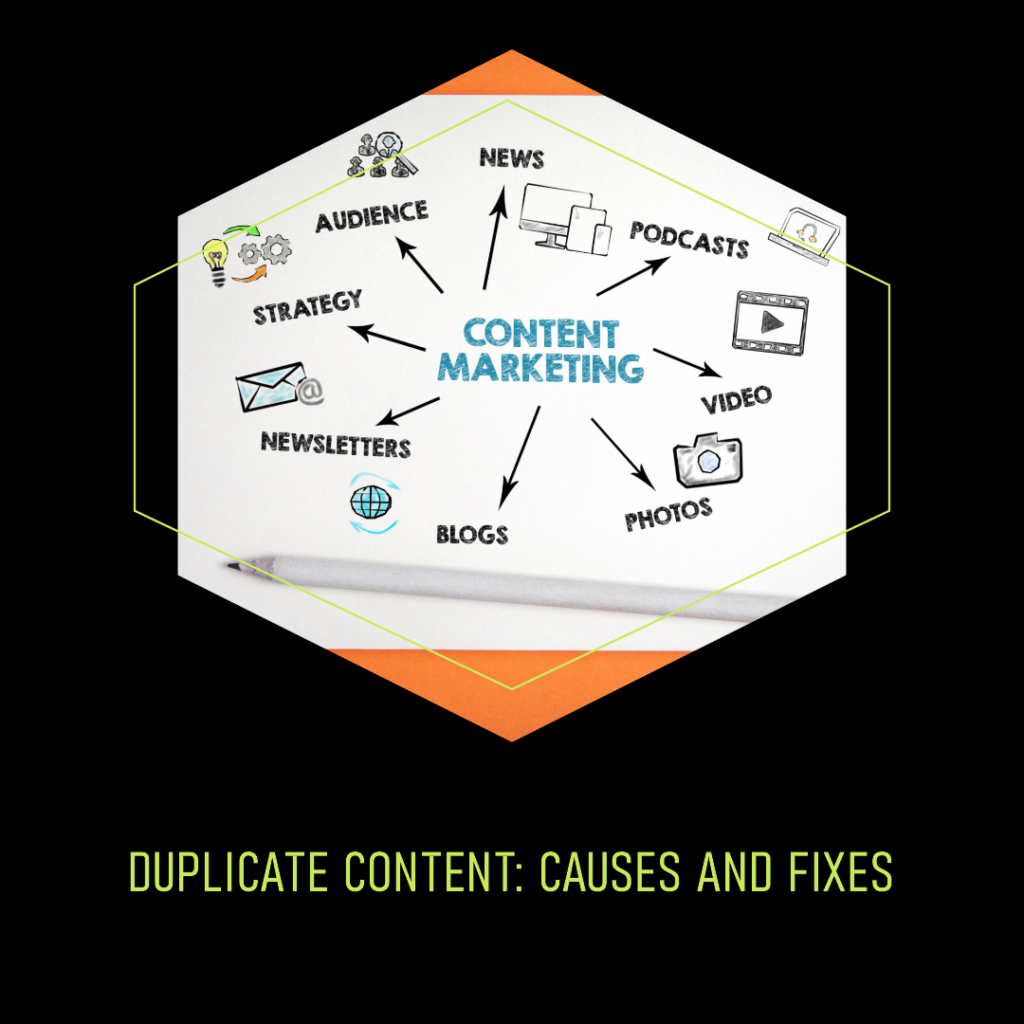Duplicate content is a common issue that website owners face when it comes to search engine optimisation. It occurs when similar content appears on multiple URLs within a website or across different websites.

Introduction
While duplicate content may not always be intentional, it can negatively impact your website’s search engine rankings and overall visibility. This blog discusses common causes of duplicate content and explores some effective solutions to address this issue.
Causes of Duplicate Content
It refers to blocks of identical content that appear in more than one location on the internet. Duplicate content can have significant repercussions affecting your website’s rankings, user experience, and even legal implications.
- Content Syndication: Content syndication involves republishing content from one website to another. While syndication can be a legitimate practice to reach a broader audience, it often leads to duplicate content issues, especially when proper attribution or canonical tags are not employed.
- Printer-friendly Versions: Websites sometimes offer printer-friendly versions of their pages, which contain the same content but, in a format, refined for printing. If search engines index both the original and printer-friendly versions, it can result in duplicate content penalties.
- WWW vs. Non-WWW Versions: Websites accessible via both “www” and “non-www” versions (e.g., example.com and www.example.com) can create duplicate content. Search engines may treat these variations as separate pages. This causes duplication.
- URL Parameters: E-commerce sites often use URL parameters to filter products or display different sorting options. If search engines index multiple URLs with different parameters but similar content, it can lead to duplicate content issues.
- Session IDs and Tracking Parameters: Websites sometimes append session IDs or track parameters to URLs. If these parameters are not managed properly, search engines may index multiple versions of the same page, each with a unique parameter. This also leads to duplicate content.
- Scraped or Copied Content: Unethical individuals may scrape content from legitimate websites and republish it on their sites without permission. This blatant plagiarism infringes upon copyright laws and creates duplicate content issues for the original content creators.
- Canonicalisation Errors: Canonicalisation is the process of selecting the preferred version of a URL when multiple choices exist. Failure to execute canonical tags correctly can result in search engines index multiple versions of the same content. This weakens its authority and relevance.
Fixes for Duplicate Content

It can be a headache to solve. It confuses search engines and harms your site’s SEO performance; it also diminishes the user experience by presenting redundant information.
However, with the right plans in place, there are different ways to effectively tackle content issues and make sure that your website remains enriched for both search engines and users. Here are effective fixes to execute:
- Canonicalisation: This is the process of specifying the preferred version of a web page when there are multiple versions of the same content. To add a canonical tag to the HTML of your web pages indicates to search engines which URL should be treated as the primary source of the content. This helps consolidate ranking signals and avoids dilution of your site’s authority across multiple URLs.
- 301 Redirects: If you have multiple URLs that lead to the same content or different versions of a page (e.g., HTTP vs. HTTPS, www vs. non-www), to apply 301 redirects is needful. A 301 redirect permanently redirects traffic from one URL to another, consolidates the link equity and certifies that search engines index the preferred version of the page. This resolves duplicate content issues and improves user experience. It seamlessly guides visitors to the correct page.
- Consolidate Similar Content: Sometimes, duplicate content issues arise from having multiple pages that offer slight variations of the same information. In such cases, it’s beneficial to combine these pages into a single, comprehensive resource. Centralise similar content into one page and redirect the redundant URLs accordingly, this shapes your site’s structure, reduces duplication, and provides users with a better browsing experience.
- Use rel=”nofollow”: In situations where you cannot harmonise duplicate content or choose a canonical version, such as syndicated content or user-generated content, using the rel=”nofollow” attribute can be a viable solution. This tells search engines not to pass authority from the original content to duplicates. It mitigates the risk of penalisation for duplicate content, it also allows users to access the information.
- Content Syndication Best Practices: If you syndicate your content on other websites or platforms, make sure that you follow best practices to avoid duplicate content issues. Use rel=”canonical” tags to attribute the source, modify content slightly to make it unique on each platform, and keep an eye on syndication partners to ensure they adhere to your guidelines. Additionally, regularly audit syndicated content to identify and address any instances of duplication.
Putting in practice these effective fixes – canonicalisation, 301 redirects, content consolidation, proper use of rel=”nofollow”, adhere to content syndication best practices can effectively resolve duplicate content issues and maintain a healthy, visible website.
Effects of Duplicate Content

While it might seem harmless at first sight, it can have significant implications for your website. The effects of duplicate content can vary. This depends on the context.
To mitigate the negative effects of duplicate content, website owners should create unique and valuable content to invoke proper canonicalisation techniques, use 301 redirects, regularly observe and address duplicate content issues.
Here are some common consequences of this kind of content:
- Search Engine Penalties: Search engines like Google aim to provide users with the most suitable and diverse content for their queries. When search engines encounter duplicate content, they may choose to penalise the pages involved by lowering their rankings or removing them from search results altogether. This can result in decreased organic traffic and visibility for affected pages.
- Confused Search Engine Indexing: Search engines may struggle to determine which version of the duplicate content to index. This leads to confusion about which page should rank for particular search queries. This can water down the authority and important signals of the affected pages, also makes it harder for them to rank well in search results.
- Wasted Crawl Budget: Search engine crawlers have limited resources allocated to crawl and index web pages. When duplicate content is present, crawlers may spend more time and resources crawling redundant pages instead of discovering and indexing new or vital content. This can negatively impact the visibility of valuable pages on a website.
- User Experience Issues: Poor user experience. When users encounter the same content across multiple pages, they may become frustrated or confused. It leads to higher bounce rates and lower attraction metrics. Provision of unique and valuable content can help you improve user satisfaction and retention.
- Backlink Dilution: If duplicate content exists across multiple websites, backlinks may be spread across different versions of the same content. This can taint the perceived authority and relevance of each version; it potentially reduces the impact of backlinks on search rankings.
- Legal Issues: In some cases, duplicate content may infringe upon copyright or intellectual property rights. This can lead to legal consequences such as takedown requests or legal action, especially if the duplicate content is used without proper attribution or permission.
Conclusion
Duplicate content can damage your website’s SEO efforts as it degrades ranking signals and confuses search engines. To understand the causes of duplicate content and applying effective fixes improves your website’s visibility and warrants a positive user experience.
Canonicalisation, 301 redirects, consistent linking, robots.txt directives, and content syndication best practices are suitable schemes to mitigate duplicate content issues and promote your website’s SEO performance. Proactively address duplicate content to strengthen your website’s authority and attract more organic traffic from search engines.
We hope this article helped you learn about Duplicate Content: Causes and Fixes. You may also want to see our guide on Content style guide and best practices for a better understanding on how to structure your content.
If you liked this article, then please subscribe to our YouTube Channel for video tutorials and more. You can also find us on LinkedIn, Twitter and Pinterest.




